The NBA Live series has long-carried a reputation as an enjoyable, though fast-paced, basketball game. Last year's NBA Live 2003 certainly lived up to that billing--and then some. It was a great game in its own right, but many criticized the game's breakneck pace and extremely arcadelike feel. While no one will confuse this year's edition with an ultrarealistic rendition of professional basketball, NBA Live 2004 definitely takes a couple of steps closer to being a more serious simulation, with a slower pace and more emphasis on defense and team play. With several additional features, as well as improvements to the game's graphics, sound, and overall polish, NBA Live 2004 is a great game for Live fans and general basketball fans alike.
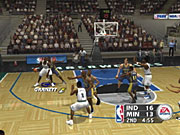
The first thing veteran Live players may notice is improvement in the game's graphics. This is particularly true of the player animations. The developers at EA Canada have used 10-man motion capturing to overhaul the appearance of the 10 players working out of the half-court. Instead of moving like individuals who have little or no awareness of their positions on the court, the players working without the ball in Live 2004 react appropriately to one another and use basketball-type maneuvers to move around in the half-court. Players cutting through the lane do so with their hands up in the ready position for a pass. Defenders swim and fight through picks to stay with their man, and post players jostle and fight for position in the low block with a great variety of animations. The new animations do give the game a more genuine feel, when running a half-court offense, and add greatly to the realism and look of Live 2004. Player models have also improved slightly, with faces that generally look very close to their real-life counterparts.
Another great addition is that most of the players in the game are wearing the same brand of shoes they wear in real life. Brands like Nike, Adidas, and Reebok are represented in the game, so you'll see Allen Iverson sporting the "Answer 6," while Tracy McGrady is decked out in his signature "T-Mac" kicks. Even the nonbrand generic shoes bear an uncanny resemblance to other brands, like And1. If you play some of the classic all-decade all-star teams, for example, you'll see old-school players, like Magic Johnson, wearing what look like Converse shoes. Many of these shoes are available in the create-a-player mode, and you're able to unlock additional Nike styles from the in-game NBA Store, which also has unlockable jerseys and other apparel. The footwear doesn't have any real impact on the gameplay, but shoes are a big part of basketball fan culture, so adding real shoes to the game is a great way to represent that.
The development team has also done a commendable job in the sound department. Aside from a great array of hip-hop tunes to get you in the mood for hooping it up, Live 2004 has gotten an upgrade in the form of new announcers. Players are now treated to the familiar voices of Marv Albert, on play-by-play, and his broadcasting partner, and former NBA coach, Mike Fratello, providing color. Albert delivers many of his signature calls, such as describing a particularly nasty dunk as "delivering the facial." Fratello, in turn, brings up very specific details about many of the players, such as referring to Jason Richardson's recent slam dunk crown and mentioning Gary Payton's nickname as "The Glove." The longtime broadcasting partners do a fantastic job and have so many different things to say that the announcing never seems to feel repetitive.
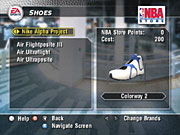
In the stands, you'll hear the crowd reacting to the activity on the court. They'll roar in response to an exciting dunk, or they'll groan listlessly if the home team starts to fall behind. Perhaps more impressive is the player and coach chatter you hear as you play the game. It's not just there as useless filler either. It's dynamic and changes, depending on the situation. If the opposing team seems to be driving to the lane at will, you'll hear your coach yell for "more pressure on the ball." If you're on defense and an opposing player moves to set a screen on your left, your teammates will actually call out "pick left." Sure, it's a little thing, but it adds a great deal of atmosphere to the game.
As far as new features in Live 2004 go, perhaps the most significant change is the separation of the shoot and dunk buttons. This means you're able to force your player to attempt a dunk or layup even if you aren't facing the basket or don't have any momentum going toward the basket. If you're too far away from the basket for a dunk, your player will try for a teardrop or a layup off the glass. This change impacts the post-game in a positive way, as you have more control over the type of shot you want to take. No matter where you are, you can always opt for the jump hook or fadeaway jumper. However, if you can get a powerful low-post player, like Shaq, and back him down under the basket, you can often just hit the dunk button, and he'll spin around and throw it down on his defender. If you try it on a defender who does have good position, however, the computer will either call you for the offensive foul, or you'll simply miss the shot with all the contact you create.
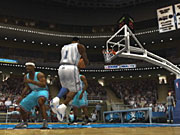
Another interesting addition is the pro hop button. By pressing this button on a drive to the basket, your player will execute a jump stop. As in real life, this maneuver can give you an extra bit of separation from the on-ball defender, freeing you up for a layup or dunk. In Live 2004, the jump stop sometimes feels a little too powerful. Even if you haven't gotten by your man, doing one can often push back the defender enough for you to get a cheap dunk. There are still drawbacks to using it. It's slower than going up for the layup directly, so that split second of delay may be enough time for a help defender to come in and block the shot. You need to weigh the pros and cons of trying to gain separation from the on-ball defender versus the possibility of getting swatted from the weak side or from behind--which is actually possible in Live 2004. Unlike last year's version, blocked shots in Live 2004 don't always go sailing out of bounds or into the back court, which is a nice change. You're usually able to rebound a swatted ball.
From the post, the pro hop button changes, in context, to become a power dribble button. By pressing it, your player attempts to drop-step around his defender. The downside is that your man will pick up the ball at the end of the maneuver, so if you haven't gotten clear, you've lost your dribble.
Rounding out the list of major new features added to the offensive side of the ball is the ability to take control of a player without the ball. By pressing the right thumbstick down and then selecting another button to choose one of the four off-ball players, you're able to move about the court to try and get open. Once you've moved to a good spot, you're able to call for a pass or an alley-oop at the basket. EA has also integrated freestyle control into moving without the ball, so you're able to make sharp cuts, spin off of defenders, slide step, and use other moves to get free from defenders for an open shot.
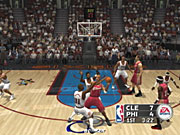
On the defensive side of the ball, you'll notice a new trapping feature has been included. If you double team the man with the ball, you'll see the two defenders position the ballhandler into a trap. The ballhandler can either pass or shoot out of the trap, but if he doesn't get rid of the ball in time, he'll usually get stripped by the defense. The trap gives the inside-outside game an added dimension of realism, as you're able to use a guard to harass a post player who has just received the entry pass and can prevent him from attempting a good shot.
At the default settings, NBA Live 2004 is noticeably slower paced than last year's game. You need to execute a lot better and more carefully out of the half-court set to be successful--particularly the higher up you ratchet the difficulty. The freestyle moves are still very useful, but they're no longer a free path to a dunk. If the defender has a good position in front of the ballhandler, the two players will collide, and the offensive player will be thwarted on his drive. The slower pace makes defense feel like less of a futile chore and more rewarding if you can get stops. If you don't like the default game settings, EA has given plenty of different slider bar options to adjust game speed, fatigue (turned off by default, even in "simulation" mode), block, steal, and foul frequency, collision radius, and more.
The franchise mode in NBA Live 2004 is adequate to the task. You've got options to sign, trade, and release players. You can set the length of the season and the format of the playoffs, and you can draft new rookies into the league. You're even able to import draft classes from EA's upcoming college basketball game, but you can always just have a class generated for you. You're also able to use earned dynasty points to buy extra coaching and training sessions for your team. You can even purchase a new team plane or locker room. All of these items for purchase can enhance your players' performances on the court. The mechanics of managing your team remains largely the same as last year's version. Basically, players are each assigned a point value that represents the value of their contracts. You need to stay under a collective point cap to sign and trade additional players and free agents.
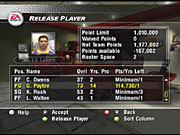
While the development team has added some extra cutscenes to illustrate major team milestones or transactions, there could have been a lot more improvement in franchise mode, which still feels somewhat thin. The rookie draft, for example, is one of the most exciting and interesting aspects of the real-life NBA. However, in NBA Live 2004, you're given very little information about any of the rookies that you would need to make an informed decision on whom to draft. Aside from position, size, and some vague ratings for players as either first- or second-round caliber, you're given no specific clues about any player's abilities, like shooting, defending, speed, and/or other relevant skills.
NBA Live 2004 has a handful of other shortcomings, most of which involve the passing game. If you try to throw an outlet pass after a defensive rebound, you'll often find that the receiving player will stop, turn around, and jump to receive the ball instead of trying to take the pass in stride. This can be frustrating, as it basically stops many fast breaks from occurring. Another strange thing is that much of the passing you do in the half-court offense can look awkward. This happens because the ballhandler will always turn his body toward a defender to protect the dribble, which, in itself, is OK. The problem is that it can be hard to force your man to face up the basket. As a result, you'll see many awkward-looking post-entry passes where your player jumps in the air, spins, and throws an overhead pass.
Another problem lies with the animations. While we certainly appreciated the added flavor of the 10-man motion capturing and the variety it brings to the half-court set, some of the other basic individual animations weren't quite as good as they could have been. Players dribbling or driving to the basket still suffer from a bit of ice-skating syndrome. Also, if you try to string together a lot of special moves, the animations can sometimes snap awkwardly from one to the next. This is especially noticeable in the post when you try to spin to the basket and use the power dribble button while there's a crowd around you.
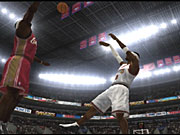
Despite these miscues, NBA Live 2004 delivers an excellent basketball experience. Hardcore players will appreciate the added control brought by the new features, like off-the-ball control and the jump stop. The separation of the dunk and shoot buttons is an especially great move that, we think, will be copied by many other games in time. Those who found last year's version to be too much of a track meet will appreciate the toned-down pace of Live 2004. They'll also appreciate the tweaks made to the defensive side of the ball, which add a lot more depth to the game. While it will mostly appeal to those who want a game with an arcade slant, NBA Live 2004 makes a worthy addition to any basketball fan's collection.